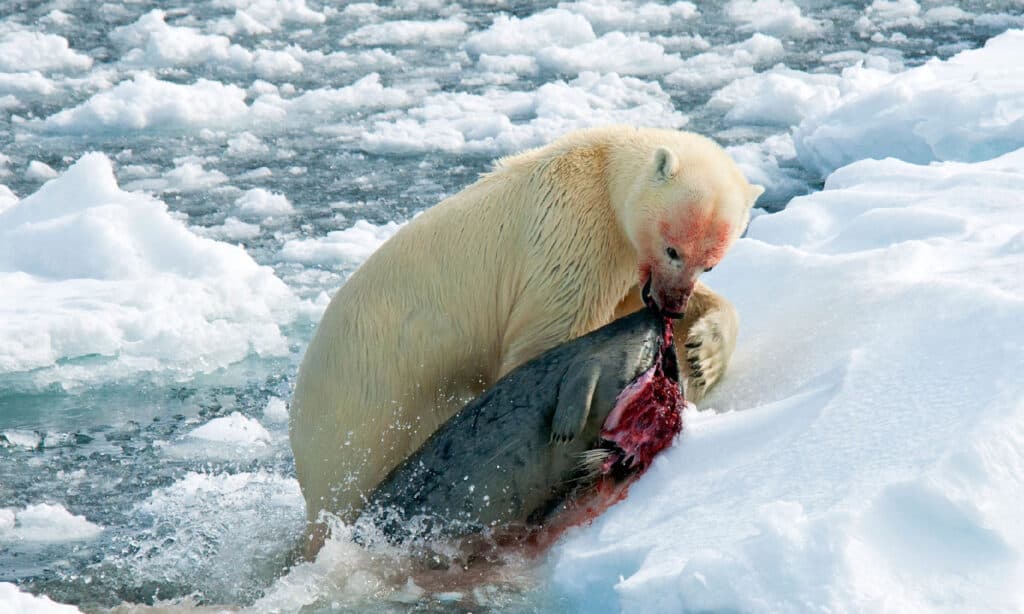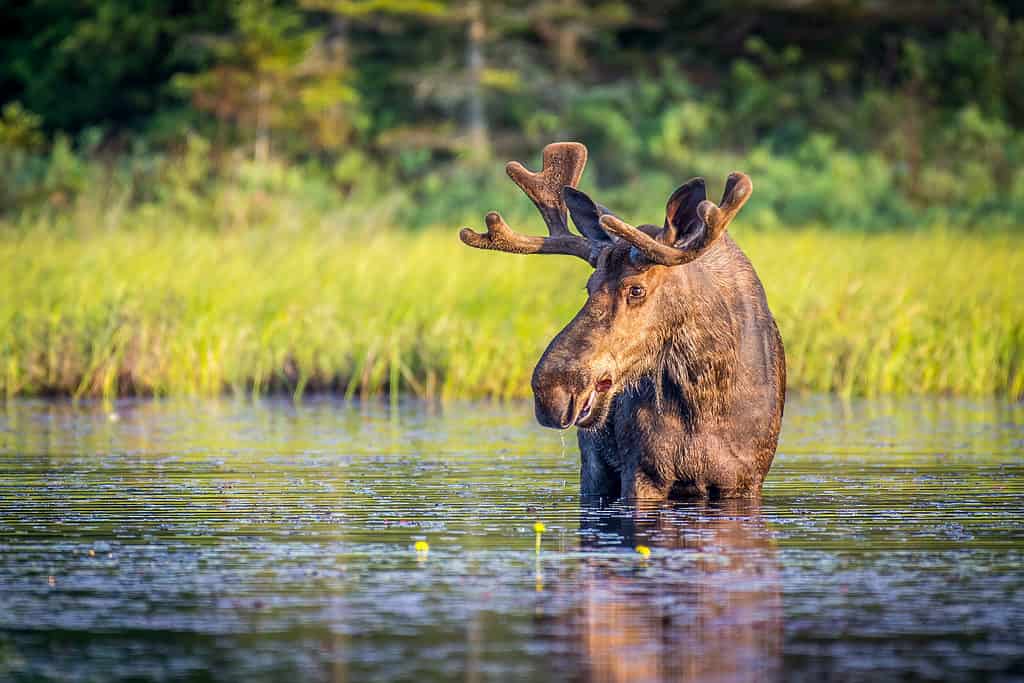What happens when a moose challenges a polar bear? We’ll find out in this animal fight club exclusive. Moose wander the northern regions of the United States. They also live throughout Canada and Alaska. Polar bears travel along the icy Arctic, often sharing territory with their cold-weathered competitor. When a hungry polar bear targets a massive moose, which animal will walk away the winner? Read on to find out the result of this polar bear vs. moose battle!
Comparing a Polar Bear vs. Moose
| Battle Factors | Polar Bear | Moose |
| Size | 5 to 8 feet tall 8 to 10 feet in length 600 to 1200 pounds | 7 feet tall 800 pounds |
| Speed | 25 mph | 35 mph |
| Characteristics | Powerful sense of smell Waits for seals to surface Stalks seals on ice Only 2% of hunts are successful | Hump hairs raise during attack Kicks and stomps predators Antlers can be weapons |
| Top Advantages | Perfect arctic physique Two layers of fur Powerful claws | Ability to crush with hooves |
Polar Bear: Fighting Advantages

When the seal pops up for air, the polar bear snatches it out of the water!
©iStock.com/AGAMI stock
Our first competitor is the polar bear. Males can weigh up to 1500 pounds, and females usually weigh about half of that. These bears spend most of their time at sea, and scientists estimate around 20,000 polar bears are left in the world.
Powerful Nose
There won’t be any chance of sneaking up on this sea bear. The polar bear will smell the moose long before seeing it. Polar bears use their keen sense of smell to find breathing holes in the ice, which belong to unsuspecting seals. When the seal pops up for air, the polar bear snatches it out of the water.
Serious Stamina and Fast Swimmers
Polar bears have serious stamina. They can swim for days as they go from one piece of ice to another. These bears are used to floating 30 miles in a stretch. There are even reports of a polar bear once swimming 220 miles!
Once the water-loving bear starts paddling toward the moose, it’ll catch up in minutes. Despite their size and bulk, polar bears can swim fast. They have slightly webbed feet, and large paws, that help them quickly paddle through the water. The front paws do a doggy paddle maneuver, while the hind feet lay flat and act as rudders. The polar bear’s nostrils even close to help them swim underwater.
Only Marine Mammal Bear
Polar bears spend so much time in the water that they’re the only bear species classified as marine mammals. The Latin name Ursus maritimus means “Sea Bear,” and it’s fitting. Polar bears spend much of their lives on the sea ice of the Arctic Ocean. The ocean waters are their way of life.
Moose: Top Fighting Advantages

Despite their large size and impressive headgear, moose are remarkable swimmers.
©Mark Byer/Shutterstock.com
Bull moose are made to fight. Coming in at 1600 pounds, these animals are enormously powerful. The moose is the largest deer species and towers over the polar bear.
Deadly Front Kick
It’ll be an instant win if the moose kicks the polar bear in the head. This hooved fighter can kick in any direction with its front legs. The polar bear better keep its face far away from the large moose’s feet, or it’ll be game over!
Large Antlers
Of course, the moose’s most iconic trait are their large antlers. Male antlers can grow up to 6 feet across. Moose also have huge shoulders, thick neck muscles, and protective skin. Their neck muscles expand to twice their normal size during the rut, and their thick forehead skin protects against punctures. The moose can knock the bear down, gore it with sharp antlers, and steal the victory.
Rut Rage
If the polar bear threatens the moose during the rutting season, this animal battle will heat up fast! From August to mid-October, moose become preoccupied with reproducing. The rutting or mating season is when moose display behaviors you won’t find any other time of year. They thrash their antlers and fight with other bulls to maintain dominance.
Strong Swimmers
Despite their large size and impressive headgear, moose are remarkable swimmers. Once the winter ice melts, moose spend most of their time swimming in rivers and lakes. This helps them stay cool during hot days. Sometimes they swim as many as 10 miles without stopping. They’ve also been seen staying completely submerged for 30 seconds or longer.
Fast Runners
Moose are impressive on land. A calf can outrun a human at just five days old! Fully grown moose can run up to 35 mph. However, they only maintain these top speeds for short distances. If they need to run for a longer time, a moose will try to maintain a speed of 20 miles per hour.
Which Cold Weather Beast Wins the Battle?
The moose wins! The world’s largest deer species is the champion of this animal battle. How was a deer-like creature able to take down a ferocious polar bear? Just look at a picture of a fully grown moose and you’ll understand.
Moose are large, tall, and in charge! They’re not an easy target, and that’s especially true during the moose’s mating season.
The moose uses its height and large antlers to shove the polar bear to the ground. After the sea bear fall, the moose gores it. Finally, the hooved heavy weight finishes the fight with a fatal kick. It’s lights out for Mr. polar bear, and the moose lives on to enjoy another day of foraging for twigs and leaves.
The photo featured at the top of this post is ©
Thank you for reading! Have some feedback for us? Contact the AZ Animals editorial team.






